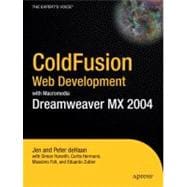
| About the Authors | ix | ||||
| Introduction | xiii | ||||
| Chapter 1 Welcome to ColdFusion MX 6.1 | 1 | (20) | |||
|
1 | (1) | |||
|
2 | (1) | |||
|
3 | (1) | |||
|
4 | (1) | |||
|
5 | (3) | |||
|
8 | (6) | |||
|
14 | (3) | |||
|
17 | (3) | |||
|
20 | (1) | |||
| Chapter 2 Databases and Dreamweaver MX 2004 | 21 | (26) | |||
|
22 | (2) | |||
|
24 | (4) | |||
|
28 | (4) | |||
|
32 | (2) | |||
|
34 | (3) | |||
|
37 | (8) | |||
|
45 | (2) | |||
| Chapter 3 Introduction to ColdFusion | |||||
|
47 | (1) | |||
|
47 | (6) | |||
|
53 | (30) | |||
|
83 | (2) | |||
| Chapter 4 ColdFusion Variables and Logic | 85 | (48) | |||
|
85 | (9) | |||
|
94 | (3) | |||
|
97 | (34) | |||
|
131 | (2) | |||
| Chapter 5 Form Processing | 133 | (44) | |||
|
133 | (3) | |||
|
136 | (6) | |||
|
142 | (5) | |||
|
147 | (6) | |||
|
153 | (2) | |||
|
155 | (3) | |||
|
158 | (8) | |||
|
166 | (2) | |||
|
168 | (3) | |||
|
171 | (3) | |||
|
174 | (2) | |||
|
176 | (1) | |||
| Chapter 6 Database Manipulation | 177 | (40) | |||
|
177 | (3) | |||
|
180 | (4) | |||
|
184 | (4) | |||
|
188 | (10) | |||
|
198 | (6) | |||
|
204 | (11) | |||
|
215 | (2) | |||
| Chapter 7 Maintaining State | 217 | (36) | |||
|
217 | (4) | |||
|
221 | (10) | |||
|
231 | (9) | |||
|
240 | (8) | |||
|
248 | (3) | |||
|
251 | (2) | |||
| Chapter 8 Exception Handling with CFML | 253 | (26) | |||
|
254 | (9) | |||
|
|||||
|
|||||
|
263 | (3) | |||
|
266 | (1) | |||
|
267 | (10) | |||
|
|||||
|
|||||
|
|||||
|
277 | (2) | |||
| Chapter 9 Dreamweaver MX 2004 Extensions | 279 | (24) | |||
|
280 | (4) | |||
|
284 | (4) | |||
|
288 | (4) | |||
|
292 | (9) | |||
|
301 | (2) | |||
| Chapter 10 Code and Component Reuse | 303 | (30) | |||
|
|||||
|
304 | (1) | |||
|
305 | (4) | |||
|
309 | (2) | |||
|
311 | (4) | |||
|
315 | (4) | |||
|
319 | (8) | |||
|
327 | (4) | |||
|
331 | (2) | |||
| Chapter 11 Working with XML In | |||||
|
333 | (1) | |||
|
333 | (3) | |||
|
336 | (3) | |||
|
339 | (3) | |||
|
342 | (5) | |||
|
347 | (3) | |||
|
350 | (5) | |||
|
355 | (2) | |||
| Chapter 12 Flash MX 2004, Web Services, and ColdFusion MX 6.1 | 357 | (52) | |||
|
358 | (1) | |||
|
358 | (1) | |||
|
359 | (1) | |||
|
359 | (7) | |||
|
366 | (2) | |||
|
368 | (1) | |||
|
369 | (2) | |||
|
371 | (1) | |||
|
371 | (1) | |||
|
372 | (2) | |||
|
374 | (6) | |||
|
380 | (4) | |||
|
384 | (14) | |||
|
398 | (10) | |||
|
408 | (1) | |||
| Chapter 13 Case Study: A Complete | |||||
|
409 | (1) | |||
|
409 | (1) | |||
|
410 | (3) | |||
|
413 | (5) | |||
|
418 | (7) | |||
|
425 | (10) | |||
|
435 | (15) | |||
|
450 | (1) | |||
| Index | 451 |
The New copy of this book will include any supplemental materials advertised. Please check the title of the book to determine if it should include any access cards, study guides, lab manuals, CDs, etc.
The Used, Rental and eBook copies of this book are not guaranteed to include any supplemental materials. Typically, only the book itself is included. This is true even if the title states it includes any access cards, study guides, lab manuals, CDs, etc.